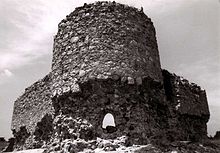Alameda de Osuna

Alameda de Osuna is a district in the Barajas district of Madrid in Spain. (The agglomeration of Madrid has 6 million inhabitants and the Comunidad Autónoma 6.5 million inhabitants) This is a housing estate with approx. 20,000 inhabitants (as of 2013) in the eastern part of the city directly at Madrid-Barajas Airport . The name of the district goes back to the property El Capricho de la Alameda de Osuna (castle and park).
In 1959 the largest drive-in cinema in Spain (and the second in Europe) with around 800 seats was built in the west of today's Alameda de Osuna . The idea for this came from the USA . The location was chosen because of its proximity to the US military airfield in Torrejón de Ardoz and the motorway. However, the drive-in theater had to be closed again after a few years because fewer American soldiers came than expected. However, this part of Alameda de Osuna is still called "El Motocine" (the drive-in cinema) today. In the mid-1960s, the first private housing companies began building blocks of flats for young middle-class families. These were condominiums that were very well located due to their location on the outskirts directly on the A2 motorway to Saragossa and only 10 km from Madrid city center. The settlement is characterized by strong greenery (public and private green areas) and a small-scale structure. The level of equipment can be described as good. In addition to swimming pools for several blocks of flats, which, depending on the housing company, rarely have more than 6 floors, the retail trade for daily needs is well represented. The transport connection to the city center is provided by a motorway, bus lines and a new subway line that has existed since 2006, so that the attractiveness as a residential location close to the city center is high. The district is located directly on the M-40 motorway (2nd ring road).
The problem of noise emissions from the immediate vicinity of the airport has not yet been solved, but has remained acute due to the immense expansion of the airport (opening of the new Terminal 4 in February 2006). The airport has an annual PAX capacity of 70 million (No. 1 in Europe and No. 3 in the world). Nevertheless, the area remains a preferred residential area. Since the 1990s, further districts have been built north of Avenida de Logroño (the road connecting La Piovera and Barajas-Pueblo), such as B. Coronales located directly on the La Hinojosa golf course.
Individual evidence
- ↑ Anuario Estadístico Barajas 2013 . Published by Ayuntamiento Madrid (Administration), p. 4. online at issuu.com
- ↑ a b Nuestro barrio . Asociación de Vecinos de Alameda de Osuna 2000, accessed November 28, 2015
- ↑ Patricia Gosálvez. A la sombra del viejo motocine . El País website of December 15, 2008, accessed November 28, 2015
- ↑ Javier Barbancho. Barajas despierta de su letargo . El Mundo website of February 28, 2014, accessed on November 28, 2015
Coordinates: 40 ° 27 '26 " N , 3 ° 35' 16" W.
